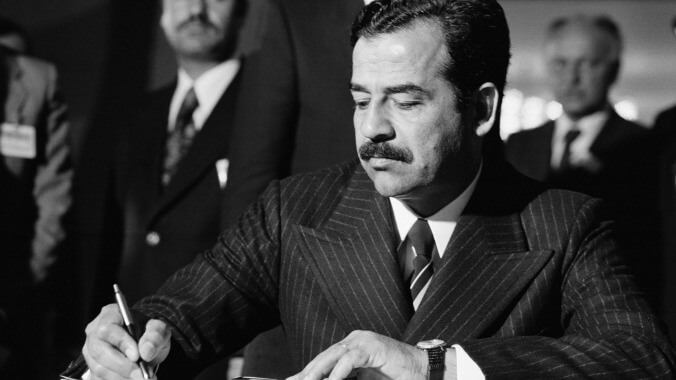Aspiring authors in novel-writing month have a kindred spirit in Saddam Hussein

We explore some of Wikipedia’s oddities in our 6,181,160-week series, Wiki Wormhole.
This week’s entry: Saddam Hussein’s novels
What it’s about: Hitler started off as a painter. Chairman Mao was an accomplished calligrapher who wrote books on philosophy. Even some of history’s greatest monsters had artistic ambitions, and Iraqi dictator Saddam Hussein was no exception. The Butcher Of Baghdad wrote four novels in the last few years of his life, published anonymously (with the traditional Arab attribution, “Written By He Who Wrote It”). But as this anonymous author’s books ended up on school syllabi across Iraq, it wasn’t too hard to figure out their identity.
Biggest controversy: We’re not 100% sure Saddam wrote all four of these books. His first novel, Zabibah And The King, about a rule of medieval Iraq who falls for a commoner and protects her from her abusive husband, was written in 2000. Esteemed literary critics the CIA believe Saddam hired ghostwriters to write the book under his supervision. But Saddam’s personal translator Sadoun al-Zubaydi insisted the dictator wrote 2002 book Men And The City (a fictionalized account of Hussein’s grandfather fighting the Ottoman Turks, and not, as we assumed from the title, four male friends bonding over Cosmopolitans and sharing details of their love lives).
Al-Zubaydi gives the backhanded defense that Hussein must have been the author because, “often the text is illegible… they were written in Saddam’s typically orderly handwriting, with few deletions and many repetitions. When he stumbled upon a new word… he would become fascinated with it and use it again and again, almost always inappropriately.”
Strangest fact: Zabibah was rumored to have a movie adaptation. When Sacha Baron Cohen began working with frequent collaborator Larry Charles on a film about a Middle Eastern dictator, rumors abounded that it was based on Hussein’s first novel. The resulting film, 2012’s The Dictator, was a modern-day spoof of self-absorbed dictators with no connection to Saddam.
Thing we were happiest to learn: Not all of Hussein’s books were thinly veiled excuses to cast himself as the hero. His 2001 book The Fortified Castle is about a veteran of the Iran-Iraq War whose wedding to a Kurdish woman is delayed; the book’s central allegory is that of unity between Iraq’s ethnic groups. His last book, Begone, Demons (supposedly finished the day before the American invasion began in 2003) is centered on “a Zionist-Christian conspiracy,” but is set in biblical times and doesn’t have an obvious Saddam stand-in character.
Thing we were unhappiest (but not surprised) to learn: Saddam’s writing was pretty heavy-handed. Zabibah’s title character’s rape and abuse at the hands of her husband (which she’s saved from by the story’s Saddam stand-in) is a clunky metaphor for the 1991 U.S. invasion. Demons unsubtly ends with its heroes destroying two massive towers.
Also noteworthy: While Saddam’s earlier books were (mandatory) bestsellers, Begone, Demons had trouble finding a publisher, given that its author had been ousted from power and executed as a war criminal. In 2006, three years after completion, a Japanese publisher printed just 8,000 copies. Saddam’s daughter Raghad, exiled to Jordan, hoped to print 100,000 copies of the book there, but the Jordanian government stepped in and prevented the book from going to press. In 2007, the book was translated to Russian, but again, only 5,000 copies were printed.
Best link to elsewhere on Wikipedia: While Hussein committed enough atrocities to condemn him many times over, we seem to remember a few allegations about his arsenal that turned out not to be true. Among them were claims that he and his son Qusay threw political opponents into a giant shredder, Fargo-style. While the shredder didn’t get as much press as, say, yellowcake uranium (thanks again, New York Times), it was also used as a justification for war. It also turned out, as Wikipedia delicately puts it, “it was determined there was not enough evidence to support the existence of such a machine.”
Further Down the Wormhole: Another false justification for war was tying Hussein and his regime to the September 11th attacks, of which he was apparently a fan, but not a perpetrator. The 9/11 page can send you down a pretty dark wormhole of terrorism-related reading, including List Of Terrorist Incidents In 2016, which features Iraq prominently (as well as mass shootings in the U.S.). But it mercifully also features a link to a far less fraught topic, the selfie. As by next Sunday we’ll no doubt still be reeling in one direction or another after the results of our 59th and final presidential election, next week as a palate cleanser we’re going to bury our heads in the silliest legal battle we could find: the monkey selfie copyright dispute.